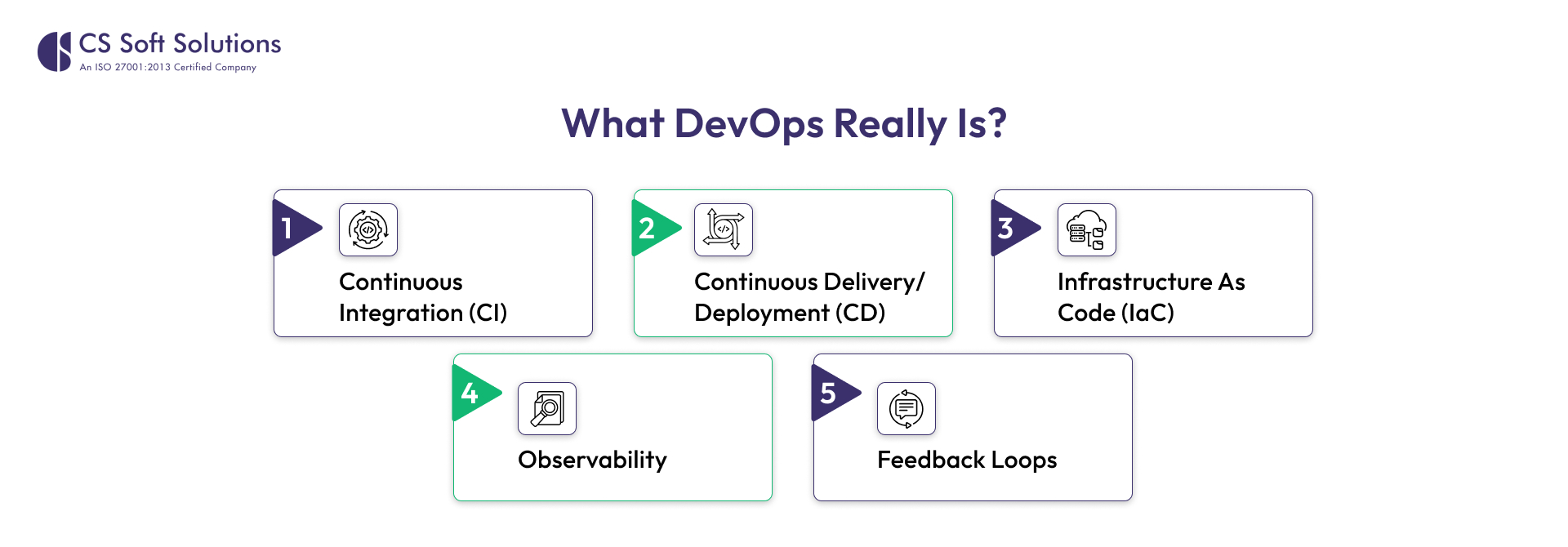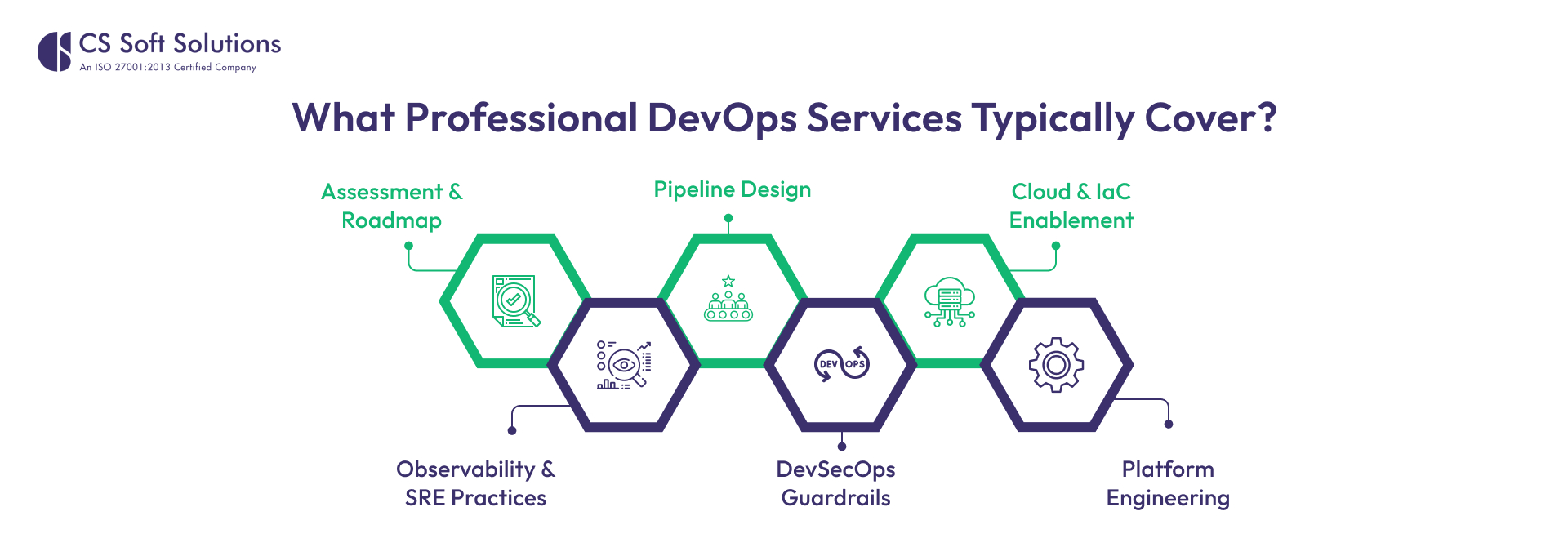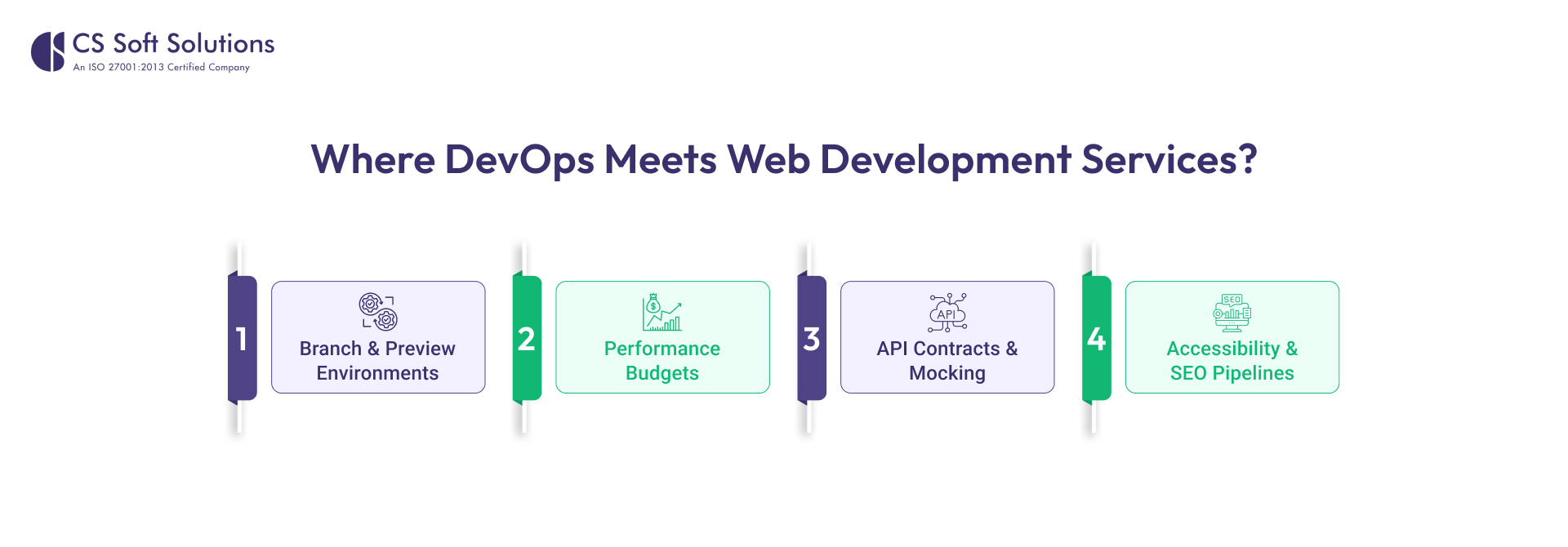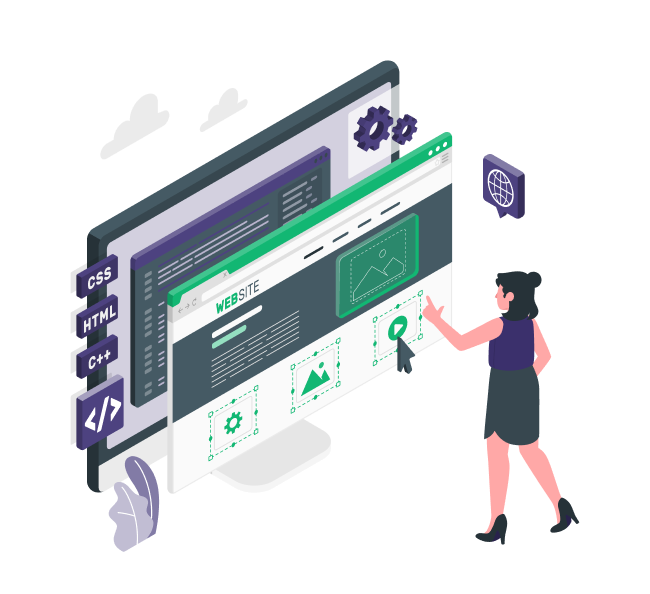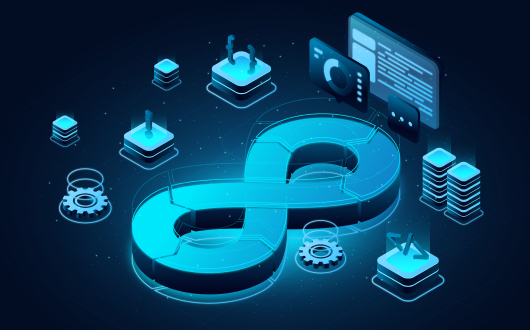
What DevOps Really Is?
DevOps isn’t a tool you buy or a single role you hire. It’s a set of engineering practices plus cultural habits that remove friction between development and operations. Think of it as choreography:
- Continuous Integration (CI): It is generally executed with automated tests and builds to add new changes.
- Continuous Delivery/Deployment (CD): It is a change that moves through the environments via repetitive pipelines and reduces human error.
- Infrastructure as Code (IaC): Versioning and automation (like application code) of servers, networks, and cloud resources.
- Observability: The logs, metrics, traces, and alerts are the items that are joined together with the ability to detect issues in a timely manner and address them promptly.
- Feedback Loops: User Signs, feature telemetry, and review of post-incident reviews, which identify the following sprint.
Through such alignment, teams no longer toss code across the wall. They are pairing and pairing, and the facts and railroad tracks.
Why DevOps Services Matter Right Now
1) Speed-to-Value without Breaking Things
Customers don’t care about release notes. They were actually result-oriented. DevOps engineering enhances the distance between idea and feature in use by automating the risky repetitive processes. Small releases have fewer tests to run, can be easily rolled back, and are nicer to your on-call staff.
2) Reliability as a Business Advantage
Uptime is not a quantification; it is brand credibility. Tests and security checks, and policy gates on pipelines decrease production surprises. Observability tools turn “we think” into “we know,” so root causes surface fast and outages become rarer and shorter.
3) Costs You Can Actually Predict
Manual deployments and hand-crafted environments burn time quietly. Infrastructure as Code, plus reusable pipeline templates, converts that time into code. You gain repeatability, cut config drift, and shrink the “it works on my machine” shrug to near zero. Fewer incidents also mean fewer late-night escalations and hidden productivity losses.
4) Culture That Keeps Talent
Developers want impact, operators want control, and security wants assurance. DevOps services define boundaries and standards so each group gets what it needs. Clear runbooks, blameless postmortems, and shared dashboards improve collaboration and retention.
What Professional DevOps Services Typically Cover
- Assessment & Roadmap: It is important to evaluate the bottlenecks, floating environments, and the actual commit to prod lead time.
- Pipeline Design: A typical CI/CD implementation will be compatible with your tech stack,artifact management, progressive delivery, and different quality gates like unit, integration, and e2e.
- Cloud/IaC Enablement: They provide a standard Terraform setup with vendor-provided and reusable modules.
- Observability & SRE Practices: SLOs, error budgets, alert tuning, incident workflows, and post-incident learning: observability and SRE Practices.
- DevSecOps Guardrails: The SBOM generation, dependency scan, secret management, and runtime protections are integrated into the pipeline.
- Platform Engineering: The platform engineering ensures that there are paved roads and golden paths that allow teams to deploy services without much ceremony.
These are the blocks that allow the teams to run both fast and safely without having to re-invent the wheel every time a sprint is on.
Where DevOps Meets Web Development Services
You can have a brilliant front end and a resilient back end, yet still struggle to ship. Web development services benefit massively from DevOps engineering:
- Branch & Preview Environments: Every pull request sets up a real preview, allowing product, design, and QA teams to validate changes visually.
- Performance Budgets: Automated lighthouse checks ensure bundle sizes remain in line and page speed remains healthy across releases.
- API Contracts and Mocking: Stable interfaces reduce the integration lag between front-end and back-end teams.
- Accessibility & SEO Pipelines: Quality requirements are not a dash to the end of the process but a daily routine.
The result? Faster response, fewer regressions, and a development route.
Common Pitfalls
Tool-first thinking: Acquisition of platforms with outcome definition is the cause of shelfware. Begin with measures: lead time, change failure rate, MTTR, and release frequency.
- Pipeline sprawl: No team that is reinventing the pipeline wheel is wasting time. Normalize templates, encode best practices one time, and reuse extensively.
- No ownership model: In the case of everybody owning reliability, no one is an owner. Bring on board service owners, on-call rotations, and escalation routes.
- Omission of documentation: IaC and pipelines need documentation and examples. You will be happy in the future, as well as the new employees.
Getting Started: Practical Steps This Month
- Measure what matters. Baseline your DORA metrics (lead time, deployment frequency, change failure rate, MTTR).
- Pick one service. Pilot CI/CD with automated tests and a staged rollout. Make improvements visible on shared dashboards.
- Codify environments. Move at least one environment (e.g., staging) to IaC with reviewable changes.
- Add guardrails. Integrate dependency and secrets scanning; generate SBOMs; set basic policy-as-code checks.
- Close the loop. Establish blameless postmortems and track follow-ups in your backlog, not in a spreadsheet that nobody revisits.
Small wins compound. The point isn’t perfection, it’s momentum.
FAQ Quick Hits
Is DevOps only for big companies?
No. Small teams gain outsized benefits because automation removes busywork and frees focus.
Do we need a dedicated DevOps team?
You need DevOps engineering expertise somewhere, full-time, fractional, or platform-led. The goal is paved roads, not gatekeepers.
Will this slow down feature work?
Upfront setup takes time. After that, features ship faster and safer because the path is predictable.
Final Thoughts: Why DevOps Services Matter
Modern business moves at the speed of deployment. When you prefer the DevOps services partners like CS Soft Solutions India Pvt. Ltd., who make delivery reliable, DevOps engineering turns the process into leverage. And when pipelines support your web development services, the whole product feels nimble because it is.






